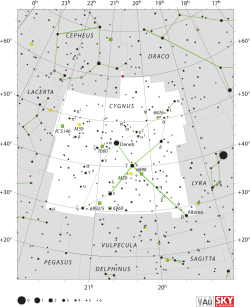32 Cygni

| |
| Observation data Epoch J2000 Equinox J2000 | |
|---|---|
| Constellation | Cygnus |
| Right ascension | 20h 15m 28.32289s[1] |
| Declination | +47° 42′ 51.1609″[1] |
| Apparent magnitude (V) | 3.98[2] |
| Characteristics | |
| Spectral type | K4–5 Ib + B6–7 IV–V[3] |
| U−B color index | +1.03[2] |
| B−V color index | +1.52[2] |
| Variable type | Eclipsing binary |
| Astrometry | |
| Radial velocity (Rv) | -14.4[4] km/s |
| Proper motion (μ) | RA: +5.30[1] mas/yr Dec.: +2.33[1] mas/yr |
| Parallax (π) | 3.08 ± 0.6[1] mas |
| Distance | approx. 1,100 ly (approx. 320 pc) |
| Orbit[5] | |
| Companion | 32 Cyg B |
| Period (P) | 1,147.8 days |
| Semi-major axis (a) | 5.50 ± 1.20 mas |
| Eccentricity (e) | 0.300 |
| Inclination (i) | 65.50 ± 8.30° |
| Periastron epoch (T) | 2433141.8 HJD |
| Argument of periastron (ω) (secondary) | 218.20° |
| Details | |
| 32 Cyg A | |
| Mass | 7.45[6] M☉ |
| Radius | 184[6] R☉ |
| Luminosity | 6,600[6] L☉ |
| Surface gravity (log g) | 0.78[6] cgs |
| Temperature | 3,840[6] K |
| Metallicity [Fe/H] | –0.43[7] dex |
| Age | Under 20 million[8] years |
| 32 Cyg B | |
| Mass | 4.13[6] M☉ |
| Radius | 3.0[6] R☉ |
| Luminosity | 302[6] L☉ |
| Temperature | 16,200[9] K |
| Other designations | |
32 Cygni (32 Cyg, Omicron2 Cyg, ο2 Cyg) is the Flamsteed designation for a binary star system in the Cygnus constellation. It is a 4th magnitude star, which can be seen with the naked eye under suitably dark skies. Parallax measurements give an estimated distance of 1,100 light-years (320 parsecs) from the Earth.[1] However, Schröder et al. (2007) suggest the actual value, after correcting for Malmquist bias, may be closer to 1,174 light-years (360 parsecs).[6]
The primary component in this system, 32 Cygni A, has a stellar classification of K4–5 Ib, indicating that it is a lower luminosity supergiant star. Its effective temperature of 3,840 K lies in the range for K-type stars,[6] giving it an orange hue.[11] This star has more four than times the mass of the Sun and the outer envelope has expanded to about 184 times the Sun's radius.[6] It is radiating 6,600 times the luminosity of the Sun.[6]
The companion star, 32 Cygni B, is smaller than the primary, with four times the Sun's mass and three times the Sun's radius.[6] It has a much higher effective temperature of 16,200 K[9] and is radiating over 300 times the Sun's luminosity.[6] This star has the blue-white hue of a B-type star, with a stellar classification of B6–7 IV–V.[3] The luminosity class 'IV–V' fits a star that has nearly exhausted the hydrogen at its core and begun to evolve off the main sequence to become a subgiant star.
The two stars form an eclipsing binary system (variable star designation: V1488 Cyg) similar to Algol. The orbital plane of the two stars is nearly aligned with the line of sight from the Earth, so that the giant star eclipses the secondary component once per orbit. During an eclipse, emission lines can be seen in the spectrum of this system. These originate in the stellar wind escaping from the giant star. In a volume around the B star, this wind becomes ionized, resulting in a circumstellar H II region.[3] The giant star is losing mass at the rate of 1.3 × 10−8 times the mass of the Sun per year, or the equivalent of the Sun's mass every 77 million years.[6]
References
- ↑ 1.0 1.1 1.2 1.3 1.4 1.5 van Leeuwen, F. (November 2007), "Validation of the new Hipparcos reduction", Astronomy and Astrophysics 474 (2): 653–664, arXiv:0708.1752, Bibcode:2007A&A...474..653V, doi:10.1051/0004-6361:20078357.
- ↑ 2.0 2.1 2.2 Johnson, H. L. et al. (1966), "UBVRIJKL photometry of the bright stars", Communications of the Lunar and Planetary Laboratory 4 (99), Bibcode:1966CoLPL...4...99J.
- ↑ 3.0 3.1 3.2 Eaton, J. A. (November 2008), "Emission Lines in 32 Cygni", The Journal of Astronomical Data, Bibcode:2008JAD....14....3E.
- ↑ Wilson, Ralph Elmer (1953), General catalogue of stellar radial velocities, Carnegie Institution of Washington, Bibcode:1953QB901.W495......
- ↑ Jancart, S. et al. (October 2005), "Astrometric orbits of SB^9 stars", Astronomy and Astrophysics 442 (1): 365–380, arXiv:astro-ph/0507695, Bibcode:2005A&A...442..365J, doi:10.1051/0004-6361:20053003.
- ↑ 6.0 6.1 6.2 6.3 6.4 6.5 6.6 6.7 6.8 6.9 6.10 6.11 6.12 6.13 6.14 Schröder, K.-P.; Cuntz, M. (April 2007), "A critical test of empirical mass loss formulas applied to individual giants and supergiants", Astronomy and Astrophysics 465 (2): 593–601, arXiv:astro-ph/0702172, Bibcode:2007A&A...465..593S, doi:10.1051/0004-6361:20066633.
- ↑ Cenarro, A. J. et al. (January 2007), "Medium-resolution Isaac Newton Telescope library of empirical spectra - II. The stellar atmospheric parameters", Monthly Notices of the Royal Astronomical Society 374 (2): 664–690, arXiv:astro-ph/0611618, Bibcode:2007MNRAS.374..664C, doi:10.1111/j.1365-2966.2006.11196.x.
- ↑ Kaler, James B., "OMI-2 CYG (Omicron-2 = 32 Cygni)", Stars (University of Illinois), retrieved 2012-01-20.
- ↑ 9.0 9.1 Malkov, O. Yu. (December 2007), "Mass-luminosity relation of intermediate-mass stars", Monthly Notices of the Royal Astronomical Society 382 (3): 1073–1086, Bibcode:2007MNRAS.382.1073M, doi:10.1111/j.1365-2966.2007.12086.x.
- ↑ "V1488 Cyg -- Eclipsing binary of Algol type", SIMBAD (Centre de Données astronomiques de Strasbourg), retrieved 2012-01-20.
- ↑ "The Colour of Stars", Australia Telescope, Outreach and Education (Commonwealth Scientific and Industrial Research Organisation), December 21, 2004, retrieved 2012-01-16.
External links
| ||||||||||||||||||||||||||||||||||||||||||||||||||||||||||||||||||||||||||||||||||||||||||